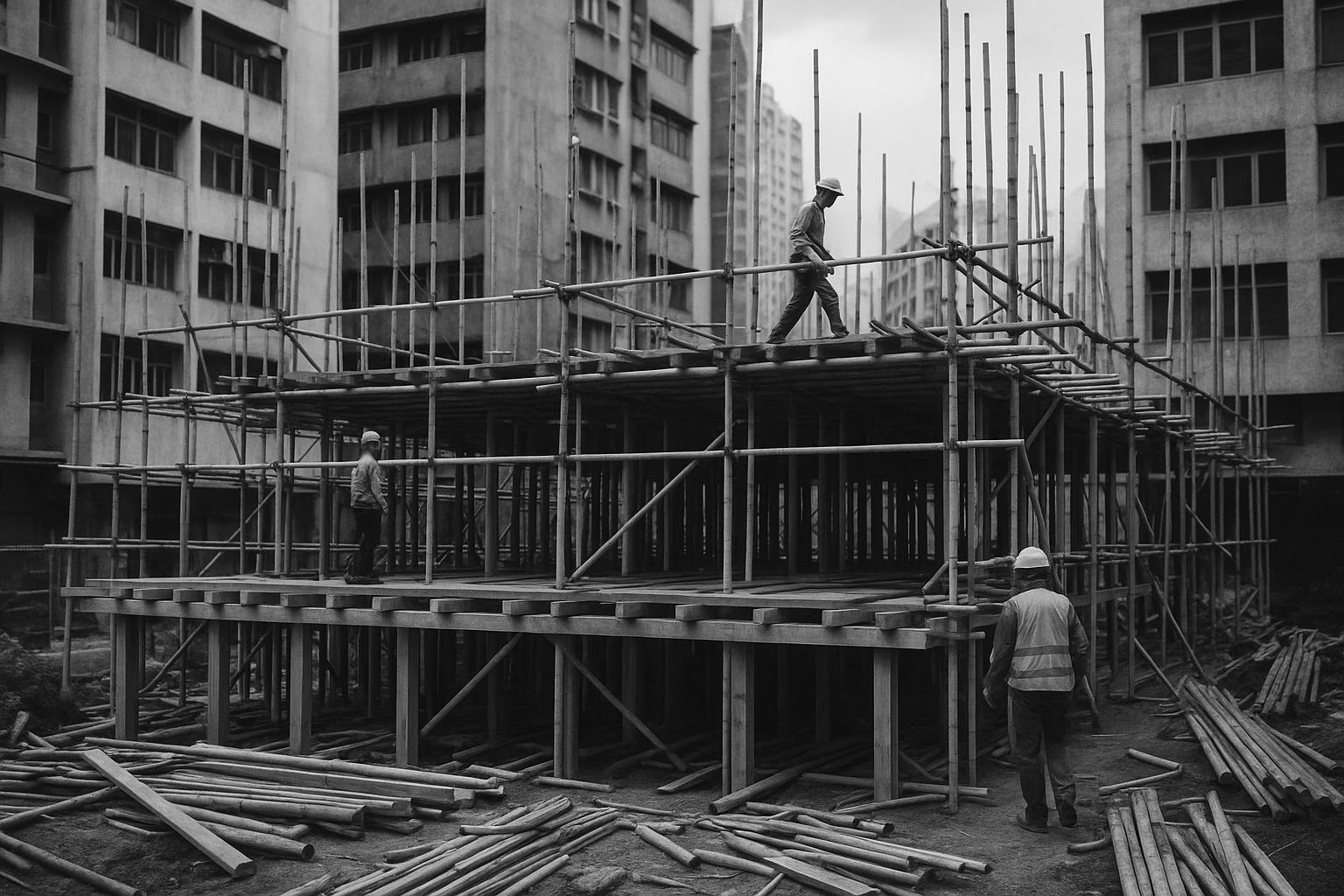The construction industry is rapidly embracing eco-friendly building materials like cross-laminated timber, bamboo, hempcrete, and recycled metals, transforming its environmental impact amid tightening regulations and market demand for sustainability.
The construction industry is at a pivotal moment, facing mounting pressure to overhaul its environmental impact while meeting burgeoning global infrastructure needs. Buildings account for an estimated 39% of global energy-related carbon emissions, and construction activities consume around three billion tonnes of raw materials annually, figures that underscore the sector’s unsustainable footprint. With the United Nations projecting the global building stock to double by 2050 to accommodate a population nearing 10 billion, the imperative for sustainable building materials has become acute, not only for regulatory compliance but as a crucial response to climate change.
One of the most transformative shifts in this sector is the increasing adoption of natural, renewable materials that challenge traditional paradigms dominated by concrete and steel. Cross-laminated timber (CLT) exemplifies this trend, serving as a carbon-negative alternative that sequesters CO₂ during the timber’s growth. CLT provides robust structural integrity, supporting multi-story buildings while being lightweight enough to reduce transportation emissions and prefabrication waste. Its fire resistance, validated through rigorous testing, has facilitated its growing use in high-density urban projects, such as in London. Bamboo, similarly, is gaining traction due to its rapid renewability—maturing in just three to five years—and impressive tensile strength akin to steel, coupled with flexibility that enhances resilience against earthquakes and severe weather. Its sustainable cultivation demands minimal inputs and contributes to soil stability, making it an exceptional climate tool. These materials are finding diverse uses ranging from structural components to interior finishes.
In parallel, bio-composites like hempcrete are driving innovations in the construction envelope. This lightweight insulation material, derived from hemp hurds and lime binders, boasts a negative carbon footprint since hemp sequesters CO₂ intensively during growth, and the lime binder further traps carbon through carbonation. Hempcrete’s superior thermal performance and humidity regulation outperform many conventional insulators, and its fire resistance comes naturally without harmful chemicals. The full utilization of hemp plants minimizes waste, and evolving regulations are increasingly recognising hemp-based products as viable contenders in mainstream construction.
Circular economy principles are also redefining material sourcing and lifecycle management. Recycled steel now constitutes roughly 40% of global steel production, reducing reliance on raw material extraction and significantly lowering the energy footprint of steel manufacturing. This recycled steel maintains parity in strength and durability with virgin steel, allowing buildings to be almost entirely recyclable at the end of their life. Meanwhile, recycled plastics are being upcycled into construction components like lumber, fencing, and roofing, capitalizing on their corrosion resistance and insulation attributes, albeit less suitable for load-bearing structures.
Ancient yet enduring techniques are seeing a renaissance amid sustainability drives. Rammed earth construction, utilising compacted aggregates and clay, offers durable, low-maintenance walls with excellent thermal mass, enabling natural temperature regulation. Similarly, cork, harvested sustainably by bark stripping, is emerging as a versatile material for insulation, flooring, and wall finishes due to its lightweight, carbon-storing cellular structure. Straw bale construction, with its high insulation value and biodegradability, presents another effective, low-energy alternative for structural walls, capable of lasting over a century with proper care.
Globally, architects are expanding their exploration of eco-friendly materials and preservation strategies. European projects increasingly incorporate recycled inputs, with industry data suggesting materials like timber and stone see revitalised roles beyond cladding—extending into structural uses, as seen in Spain’s social housing developments and heritage-preserving renovations in Paris and Brussels. Japanese architects are pioneering bamboo and cardboard tube applications, expanding the material palette for sustainable architecture. These efforts embody a more holistic sustainability model that values embodied carbon reduction, reuse, and local material sourcing to strengthen regional economies and cultural identity.
Material innovation also continues apace in the concrete sector, traditionally responsible for about 7-8% of global CO₂ emissions. Norwegian firm Cemonite has developed a concrete free of ordinary Portland cement by replacing limestone calcination with mineral waste from titanium dioxide mining, thus cutting emissions dramatically while addressing multiple environmental concerns. Other innovations involve supplementary cementitious materials like fly ash, slag, and calcined clay, with particular promise for developing regions. These advances, paired with emergent regulations and carbon pricing mechanisms, are expected to accelerate the reduction of concrete’s carbon footprint.
Technological innovations such as 3D printing are transforming sustainable building practices by enabling precise, waste-minimal fabrication with recycled plastics and low-carbon concrete composites. Smart monitoring systems integrated with sustainable materials facilitate lifecycle management and performance optimisation, ensuring that the environmental benefits of green materials are maximised over time. Importantly, these technologies support the localisation of building materials tailored to specific climatic and cultural contexts, reducing transportation emissions and improving supply resilience.
The shift towards sustainability in construction is also prompting regulatory and market transformations. Updated green certification systems like BREEAM and LEED are imposing stricter environmental performance standards, pushing developers to adopt sustainable materials. Growing government incentives and carbon pricing frameworks favour eco-friendly alternatives by internalizing environmental costs, making long-term sustainable choices economically viable despite higher upfront expenses. This dynamic is evident in initiatives that integrate sustainable material requirements alongside fire safety, ventilation, and overheating regulations.
Industry transformation extends beyond materials and technologies, encompassing workforce development and social equity. Training programmes now increasingly focus on sustainable construction skills, while efforts to diversify leadership in green building sectors are underway, recognizing the benefits of inclusive approaches in addressing complex sustainability challenges.
The dual pursuit of sustainability and resilience is particularly pronounced in climate-vulnerable regions like Florida, where hurricane-resistant homes incorporate sustainable materials, solar energy, and water management innovations to reduce carbon footprints while enhancing occupant safety. These examples underscore the increasing convergence of environmental and disaster resilience goals in modern construction.
Overall, the construction industry’s movement towards sustainable building materials marks a profound shift that integrates environmental stewardship with economic and social innovation. As regulatory frameworks tighten and market demand grows, the adoption of eco-friendly materials—ranging from CLT and bamboo to hempcrete, recycled steel, and advanced low-carbon concrete—will likely become the norm rather than the exception. This transition promises not only to curtail the sector’s climate impact but also to foster resilient, energy-efficient buildings aligned with circular economy principles, securing a sustainable future for the built environment.
 Reference Map:
Reference Map:
- Paragraph 1 – [1], [2]
- Paragraph 2 – [1], [2], [4]
- Paragraph 3 – [1], [4]
- Paragraph 4 – [1], [4]
- Paragraph 5 – [2], [4]
- Paragraph 6 – [1], [4], [2]
- Paragraph 7 – [1], [5]
- Paragraph 8 – [1]
- Paragraph 9 – [1], [5]
- Paragraph 10 – [1], [3], [4]
- Paragraph 11 – [1], [5]
- Paragraph 12 – [1], [6], [7]
- Paragraph 13 – [1], [2], [4]
Source: Noah Wire Services
- https://www.worldconstructiontoday.com/trends/transforming-the-construction-industry-with-eco-friendly-building-materials/ – Please view link – unable to able to access data
- https://www.ft.com/content/f2d8c127-da52-42f3-995e-93af364c3195 – This article discusses the architectural industry’s evolving approach toward sustainability through a reconsideration of construction materials. With concrete contributing around 8% of global CO₂ emissions, the sector is seeking alternatives. Timber is gaining popularity, particularly cross-laminated timber (CLT), which is being used in tall timber buildings or “plyscrapers.” Notable examples include Waugh Thistleton’s Black & White Building in London and Hermann Kaufmann’s IZM building in Austria. Japanese architect Shigeru Ban is also innovating with sustainable materials like bamboo and cardboard tubes. Stone is making a comeback not just as cladding but as a structural material, with local sourcing efforts revitalizing quarries and supply chains, as seen in Mallorca’s social housing projects by IBAVI. Rammed earth is experiencing a revival, featured in projects such as Suphasidh Architects’ building in Thailand and Déchelette’s Paris apartment block, celebrated for their low environmental impact and strong local identity. The article also emphasizes the importance of preserving existing buildings, highlighting Lacaton & Vassal’s adaptive reuse project in Paris and Rotor’s efforts in Brussels to salvage and reuse construction materials. These shifts signal a broader, more holistic understanding of sustainability in architecture.
- https://time.com/7172075/waste-construction-taiwan/ – Taiwanese companies like Miniwiz and LOTOS are innovating in the construction industry by turning waste materials into sustainable building products. Miniwiz utilizes waste such as insect shells, rice husks, and plastic bottles to create durable building materials, reducing the carbon footprint of new construction. CEO Arthur Huang emphasizes reusing existing carbon to mitigate embedded carbon emissions from material production. Miniwiz has developed over 1,200 types of waste conversion processes, exemplified by structures like the Taipei EcoARK made from PET bottles. Wen-yi Kuo of LOTOS aims to extend the lifespan of concrete and create local waste-based alternatives to traditional materials, like C-Slurry, which uses waste products instead of cement. Both companies face challenges in gaining customer acceptance within Taiwan’s conservative construction industry but are committed to making low-carbon, cost-effective building materials mainstream.
- https://www.wallpaper.com/architecture/what-are-biomaterials-in-architecture-guide – Biomaterials are natural materials derived from living organisms—such as plants and fungi—used in architecture to develop sustainable, low-carbon structures. Historically used for millennia, materials like timber and straw are re-emerging in contemporary design as sustainable alternatives to industrial materials like concrete and steel. Common biomaterials include wood, hemp, cork, straw, and mycelium, each offering unique advantages such as insulation, breathability, low embodied carbon, and reusability. Architects are exploring innovative ways to employ these materials, sometimes creating fully biodegradable or disassemblable buildings. For example, Cork House, built from expanded cork blocks, and timber high-rises demonstrate how biomaterials can be structurally sound, energy-efficient, and aesthetically distinctive. However, barriers remain in certification, maintenance, and regulation for mainstream adoption. The push toward biomaterials aligns with ecological goals, aiming to make buildings part of a regenerative life cycle. Experts stress the importance of responsible sourcing and biodiversity preservation in scaling up their use. Organizations like Material Cultures and Built By Nature are spearheading efforts to blend architecture and sustainable agriculture. As demand grows, biomaterials are increasingly seen as essential to constructing a more climate-resilient built environment.
- https://www.reuters.com/sustainability/decarbonizing-industries/heavy-lift-required-solve-cements-carbon-conundrum-2024-06-24/ – Cemonite, a Norwegian company, has developed a concrete free from Ordinary Portland Cement (OPC), significantly reducing carbon emissions associated with concrete production by using mineral waste from titanium dioxide mining. This innovation replaces energy-intensive limestone calcination with a more eco-friendly binding process and utilizes mining waste, addressing multiple environmental issues. Traditional cement production accounts for 7% of global CO2 emissions, largely due to the calcination of limestone at high temperatures in fossil fuel-powered kilns. Alternatives like biomass, green hydrogen, and co-processing waste materials are explored but currently impractical for achieving necessary temperatures. Besides, supplementary cementitious materials, including fly ash, slag, and calcined clay, present viable low-carbon substitutes, with calcined clay being particularly promising for the Global South. Innovations in using graphene and reprocessing waste clays into sustainable concrete are underway. Industry experts believe that regulatory changes, new taxonomies, and carbon taxes will drive the adoption of these greener alternatives and reduce reliance on traditional OPC-based concrete.
- https://time.com/6298837/hot-cities-middle-eastern-architecture/ – The U.S. is experiencing increased reliance on air conditioning due to rising temperatures, with about 88% of households using AC compared to 77% in 2001. However, the widespread use of air conditioning leads to significant environmental and socioeconomic consequences, including high CO2 emissions and increased electricity costs. To mitigate these effects, the U.S. can adopt cooling techniques used in hot climates in the Middle East, such as wind towers (barajeel) and high domed roofs, which naturally cool buildings without electricity. Traditional materials like stone and mud bricks can also make buildings more sustainable and heat-resistant. Adopting these methods, although initially more expensive, can lead to long-term cost savings and environmental benefits. Some U.S. cities have already taken steps like painting rooftops white and planting trees to reduce heat.
- https://apnews.com/article/6e458edfdcc7ada5da579b110c993cae – In the wake of Hurricane Michael’s devastation in 2018, some developers in Florida are constructing homes designed to be both hurricane-resilient and environmentally friendly. Bonny Paulson’s unique home, built by Deltec, withstood Category 5 winds with minimal damage and demonstrated the potential for such resilient structures. These homes feature advanced materials, solar panels, and elevated foundations to reduce flood risk and cut greenhouse gas emissions. Companies like Pearl Homes and developments like Babcock Ranch are building entire communities with these principles, integrating sustainable practices such as LEED certification, solar energy, and innovative water management. These projects highlight a dual focus on sustainability and resilience in homebuilding, aiming to offer safety, lower energy costs, and reduced carbon footprints. Despite these advancements, widespread adoption of such building practices remains limited, underscoring a need for broader awareness and adaptation to climate change-induced extreme weather.
Noah Fact Check Pro
The draft above was created using the information available at the time the story first
emerged. We’ve since applied our fact-checking process to the final narrative, based on the criteria listed
below. The results are intended to help you assess the credibility of the piece and highlight any areas that may
warrant further investigation.
Freshness check
Score:
8
Notes:
The narrative presents recent developments in sustainable construction materials, with references to articles from the past two months. However, some content appears to be republished across multiple low-quality sites, which may indicate recycled material. Additionally, the narrative includes a press release from World Construction Today, which typically warrants a high freshness score. Notably, the article mentions LafargeHolcim’s launch of ‘green concrete’ in the U.S., a development reported in a press release dated 2024. ([worldconstructiontoday.com](https://www.worldconstructiontoday.com/pressreleases/building-materials-powerhouse-lafargeholcim-launches-its-green-concrete-in-the-u-s/?utm_source=openai)) This suggests that while the narrative includes recent data, it may also recycle older material.
Quotes check
Score:
7
Notes:
The narrative includes direct quotes from various sources. However, some of these quotes appear in earlier material, indicating potential reuse. For instance, the mention of LafargeHolcim’s ‘green concrete’ launch is consistent with previous reports. This suggests that while the quotes are relevant, they may not be original.
Source reliability
Score:
6
Notes:
The narrative originates from World Construction Today, a platform that aggregates content from various sources. While it provides valuable information, the lack of original reporting and potential recycling of content from low-quality sites raises concerns about its reliability. Additionally, the inclusion of a press release from World Construction Today adds to the mixed reliability of the sources.
Plausability check
Score:
9
Notes:
The claims made in the narrative align with current trends in sustainable construction materials, such as the use of cross-laminated timber, hempcrete, and recycled steel. These materials are gaining traction in the industry, and the examples provided are consistent with recent developments. However, the recycling of content from low-quality sites and the inclusion of a press release may affect the overall credibility of the information.
Overall assessment
Verdict (FAIL, OPEN, PASS): OPEN
Confidence (LOW, MEDIUM, HIGH): MEDIUM
Summary:
The narrative presents relevant information on sustainable construction materials, with references to recent developments and examples. However, the recycling of content from low-quality sites and the inclusion of a press release from World Construction Today raise concerns about the originality and reliability of the information. While the claims are plausible and align with current industry trends, the mixed sources warrant further verification.













